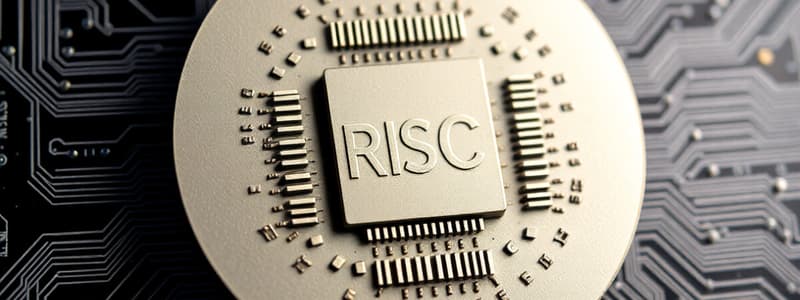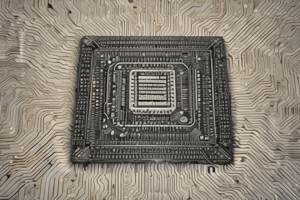Podcast
Questions and Answers
Which register holds the address of the instruction currently being executed?
Which register holds the address of the instruction currently being executed?
- Memory Buffer Register (MBR)
- Instruction Register (IR)
- Program Counter (PC) (correct)
- Memory Address Register (MAR)
What is the primary function of the Control Unit (CU) in a computer architecture?
What is the primary function of the Control Unit (CU) in a computer architecture?
- Control the behavior of other components (correct)
- Store data in memory
- Provide input/output interfaces
- Execute instructions directly
What is the role of the Memory Buffer Register (MBR)?
What is the role of the Memory Buffer Register (MBR)?
- To manage communication between input/output devices
- To hold the next instruction to be executed
- To temporarily store data during memory operations (correct)
- To keep track of the memory address of the last operation
In the context of computer architecture, which statement best defines 'Architecture'?
In the context of computer architecture, which statement best defines 'Architecture'?
Which of the following best describes the difference between computer architecture and organization?
Which of the following best describes the difference between computer architecture and organization?
Which of the following components is NOT typically associated with computer architecture?
Which of the following components is NOT typically associated with computer architecture?
What does the FDE cycle stand for in computer architecture?
What does the FDE cycle stand for in computer architecture?
What is the main characteristic of the von Neumann architecture?
What is the main characteristic of the von Neumann architecture?
How does RISC architecture primarily differ from CISC architecture?
How does RISC architecture primarily differ from CISC architecture?
What is the primary function of an ALU (Arithmetic Logic Unit) in a computer?
What is the primary function of an ALU (Arithmetic Logic Unit) in a computer?
In the context of computer architecture, what is the role of a multiplexer (MUX)?
In the context of computer architecture, what is the role of a multiplexer (MUX)?
Which of the following best defines the term 'organization' in computer architecture?
Which of the following best defines the term 'organization' in computer architecture?
What is a common component that interacts closely with the ALU in processor architecture?
What is a common component that interacts closely with the ALU in processor architecture?
What is the purpose of the FETCH stage in the FDE cycle?
What is the purpose of the FETCH stage in the FDE cycle?
During which stage of the FDE cycle is the instruction determined and appropriate registers prepared?
During which stage of the FDE cycle is the instruction determined and appropriate registers prepared?
What does the EXECUTE stage involve in the FDE cycle?
What does the EXECUTE stage involve in the FDE cycle?
Which of the following describes a characteristic of RISC architecture?
Which of the following describes a characteristic of RISC architecture?
What is a primary advantage of CISC architecture?
What is a primary advantage of CISC architecture?
In the context of computer architecture, what does CISC stand for?
In the context of computer architecture, what does CISC stand for?
Which statement about RISC and CISC is true?
Which statement about RISC and CISC is true?
What is the primary focus of the FETCH stage in the FDE cycle?
What is the primary focus of the FETCH stage in the FDE cycle?
What is the primary role of the Control Unit in a computer's architecture?
What is the primary role of the Control Unit in a computer's architecture?
Which of the following best defines the Fetch-Decode-Execute (FDE) cycle?
Which of the following best defines the Fetch-Decode-Execute (FDE) cycle?
What does the PC (Program Counter) do during the FETCH phase of the FDE cycle?
What does the PC (Program Counter) do during the FETCH phase of the FDE cycle?
In terms of computer functions, what does data movement refer to?
In terms of computer functions, what does data movement refer to?
During the ADD operation, what is primarily stored in the first operand?
During the ADD operation, what is primarily stored in the first operand?
Which component in the computer structure is responsible for interpreting the instructions from the FDE cycle?
Which component in the computer structure is responsible for interpreting the instructions from the FDE cycle?
What happens to the Program Counter (PC) during the FETCH phase after the address is read?
What happens to the Program Counter (PC) during the FETCH phase after the address is read?
Which of the following is NOT considered a primary function of a computer?
Which of the following is NOT considered a primary function of a computer?
Flashcards are hidden until you start studying
Study Notes
Computer Architecture Fundamentals
- von Neumann Architecture features a single memory and stored program concepts, introduced by scientist John von Neumann.
- Key components include Input/Output devices, CPU, and Memory, managed through interactions among units.
- Arithmetic Logic Unit (ALU) performs arithmetic and logical operations, foundational in processing.
- Essential digital circuits to remember: Full Adder, Half Adder, Multiplexer (MUX), and Decoder.
Architecture vs Organization
- Architecture encompasses attributes visible to the programmer, such as instruction sets, data representation, I/O mechanisms, and addressing techniques.
- Organization refers to how these features are implemented, including control signals, interfaces, and memory technology.
- Structure pertains to the relationships between components, while Function addresses the operations of individual components in the overall system.
- Functions of computers include Data Processing, Data Storage, Data Movement, and Control.
Fetch-Decode-Execute (FDE) Cycle
- FDE Cycle, or Instruction Cycle, involves fetching an instruction, decoding it, and executing it.
- The Fetch stage includes retrieving the instruction from memory based on the address indicated by the Program Counter (PC).
- The Decode stage prepares the relevant registers and identifies operand requirements.
- The Execute stage processes the instruction using appropriate circuits and registers.
RISC vs CISC
- RISC (Reduced Instruction Set Computer) uses a small, optimized instruction set for efficiency.
- CISC (Complex Instruction Set Computer) has a larger, more specialized instruction set that simplifies programming and makes effective use of memory.
Studying That Suits You
Use AI to generate personalized quizzes and flashcards to suit your learning preferences.



